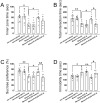The combination of fluoxetine and environmental enrichment reduces postpartum stress-related behaviors through the oxytocinergic system and HPA axis in mice
- PMID: 33875712
- PMCID: PMC8055994
- DOI: 10.1038/s41598-021-87800-z
The combination of fluoxetine and environmental enrichment reduces postpartum stress-related behaviors through the oxytocinergic system and HPA axis in mice
Abstract
Gestational stress can increase postpartum depression in women. To treat maternal depression, fluoxetine (FLX) is most commonly prescribed. While FLX may be effective for the mother, at high doses it may have adverse effects on the fetus. As environmental enrichment (EE) can reduce maternal stress effects, we hypothesized that a subthreshold dose of FLX increases the impact of EE to reduce anxiety and depression-like behavior in postpartum dams exposed to gestational stress. We evaluated this hypothesis in mice and to assess underlying mechanisms we additionally measured hypothalamic-pituitary-adrenal (HPA) axis function and brain levels of the hormone oxytocin, which are thought to be implicated in postpartum depression. Gestational stress increased anxiety- and depression-like behavior in postpartum dams. This was accompanied by an increase in HPA axis function and a decrease in whole-brain oxytocin levels in dams. A combination of FLX and EE remediated the behavioral, HPA axis and oxytocin changes induced by gestational stress. Central administration of an oxytocin receptor antagonist prevented the remediating effect of FLX + EE, indicating that brain oxytocin contributes to the effect of FLX + EE. These findings suggest that oxytocin is causally involved in FLX + EE mediated remediation of postpartum stress-related behaviors, and HPA axis function in postpartum dams.
Conflict of interest statement
The authors declare no competing interests.
Figures





Similar articles
-
Fluoxetine normalizes the effects of prenatal maternal stress on depression- and anxiety-like behaviors in mouse dams and male offspring.Behav Brain Res. 2016 Sep 15;311:354-367. doi: 10.1016/j.bbr.2016.05.062. Epub 2016 Jun 1. Behav Brain Res. 2016. PMID: 27263073
-
Maternal exercise increases but concurrent maternal fluoxetine prevents the increase in hippocampal neurogenesis of adult offspring.Psychoneuroendocrinology. 2018 May;91:186-197. doi: 10.1016/j.psyneuen.2018.02.027. Epub 2018 Mar 1. Psychoneuroendocrinology. 2018. PMID: 29579632
-
Perinatal fluoxetine dose-dependently affects prenatal stress-induced neurobehavioural abnormalities, HPA-axis functioning and underlying brain alterations in rat dams and their offspring.Reprod Toxicol. 2021 Sep;104:27-43. doi: 10.1016/j.reprotox.2021.06.014. Epub 2021 Jun 26. Reprod Toxicol. 2021. PMID: 34186199
-
Estrogen Receptors Modulation of Anxiety-Like Behavior.Vitam Horm. 2017;103:27-52. doi: 10.1016/bs.vh.2016.08.004. Epub 2016 Oct 13. Vitam Horm. 2017. PMID: 28061972 Free PMC article. Review.
-
The HPA Axis During the Perinatal Period: Implications for Perinatal Depression.Endocrinology. 2018 Nov 1;159(11):3737-3746. doi: 10.1210/en.2018-00677. Endocrinology. 2018. PMID: 30256957 Review.
Cited by
-
Electroacupuncture Ameliorates Hypothalamic‒Pituitary‒Adrenal Axis Dysfunction Induced by Surgical Trauma in Mice Through the Hypothalamic Oxytocin System.Neurochem Res. 2023 Nov;48(11):3391-3401. doi: 10.1007/s11064-023-03984-y. Epub 2023 Jul 12. Neurochem Res. 2023. PMID: 37436613
-
Early Life Stress and Metabolic Plasticity of Brain Cells: Impact on Neurogenesis and Angiogenesis.Biomedicines. 2021 Aug 26;9(9):1092. doi: 10.3390/biomedicines9091092. Biomedicines. 2021. PMID: 34572278 Free PMC article. Review.
-
Stimulated Parotid Saliva Is a Better Method for Depression Prediction.Biomedicines. 2022 Sep 7;10(9):2220. doi: 10.3390/biomedicines10092220. Biomedicines. 2022. PMID: 36140321 Free PMC article.
-
Dual Approach to Depression: The Combined Efficacy of Intermittent Hypoxia and Fluoxetine in Modulating Behavioral and Inflammatory Responses.Biomedicines. 2024 Sep 18;12(9):2116. doi: 10.3390/biomedicines12092116. Biomedicines. 2024. PMID: 39335629 Free PMC article.
-
A novel mouse model of postpartum depression using emotional stress as evaluated by nesting behavior.Sci Rep. 2021 Nov 19;11(1):22615. doi: 10.1038/s41598-021-02004-9. Sci Rep. 2021. PMID: 34799651 Free PMC article.
References
-
- Ashley, J. M., Harper, B. D., Arms-chavez, C. J. & Lobello, S. G. Estimated prevalence of antenatal depression in the US population. 395–400 (2016) doi:10.1007/s00737-015-0593-1. - PubMed
Publication types
MeSH terms
Substances
LinkOut - more resources
Full Text Sources
Other Literature Sources
Medical
Research Materials

